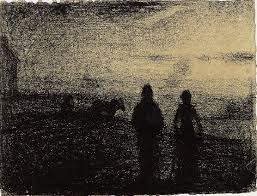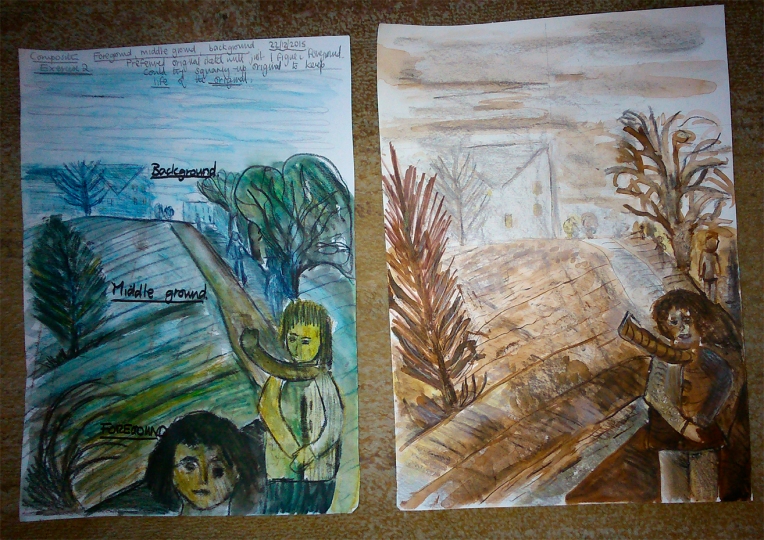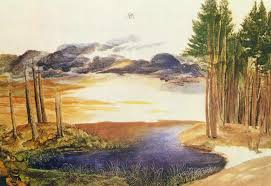Comparisons of the approaches of contemporary artists working with landscape with earlier artists.
 Tacita Dean (2012) Blackboard Drawings (Installation) Fatigues.
Tacita Dean (2012) Blackboard Drawings (Installation) Fatigues.
 Georges Seurat, (1882-83) The Ploughing.
Georges Seurat, (1882-83) The Ploughing.
There are both similarities and differences between these two art works. First Tacita Dean uses black and white like Seurat to create both drama and mystery. However Dean’s Fatigues is huge compared with the size of Seurat’s drawing. Nevertheless the shapes, inspite of the difference in scale, both have a shimmering effect. Both artists define their forms through tone and outline. Line does not predominate. Also in both works abstraction is evident even though landscape is suggested. Dean’s Fatigues reminds me of clouds or weird ‘masses’ floating across the sky, the images give the impression of movement, as though they are caught floating in the air. In contrast Seurat’s image is all stillness .The mystery of both images leaves open their interpretation to the viewer in a way that a more figurative piece would not.
______________________________________________________

Carel Weight – (1962) Daisy in the garden.
. Samuel Palmer, (1825) The Valley Thick with Corn.
Samuel Palmer, (1825) The Valley Thick with Corn.
Both artists, create a unique sense of place. In Palmers’ pen and ink, monochromatic, picture, the bountifulness of Nature is depicted through the ripening corn, the animals, trees, everything is coming to fruition. Man, or maybe a labourer, is seen as central to Nature and is placed in the middle and bottom of the composition. It is a romantic vision. Carel Weight depicts a suburban setting in which a single woman is depicted . There is a slight feeling of threat in the setting suggested by the trees , ramshackle fence and angle of the buildings – it is the composition that , above all, creates this feeling of unease – maybe the figure is lonely – the picture certainly suggests a narrative. Importantly sentimentality is absent from these expressive works.
__________________________________________________________
.  Robert Colquhoun (1914-1942)
Robert Colquhoun (1914-1942)
1942, Church Lench.
Van Gogh’s La Crau from Montmajour (1888).

Colquhoun’s landscape is close up, the packed composition conveys the feeling of a riot of trees and foliage emerging from undulating land. Like the Palmer (above) it conveys the fecundity of Nature. Colours are fairly monochromatic apart from the blue in the sky. In contrast Van Gogh’s landscape depicts vast distance with the marks getting smaller and smaller. This is done with a pen using a variety of spots, flecks, lines and so on. So three -dimensional space in the Colquhoun is conveyed mainly by shape and colour and in the Van Gogh by different sized marks. Both the shapes in Church Lench and the marks in La Crau from Montmajour create movement.








 Tacita Dean (2012) Blackboard Drawings (Installation) Fatigues.
Tacita Dean (2012) Blackboard Drawings (Installation) Fatigues.  Georges Seurat, (1882-83) The Ploughing.
Georges Seurat, (1882-83) The Ploughing.
 Samuel Palmer, (1825) The Valley Thick with Corn.
Samuel Palmer, (1825) The Valley Thick with Corn. Robert Colquhoun (1914-1942)
Robert Colquhoun (1914-1942)













 George Shaw The Appointment.
George Shaw The Appointment. View of a pond by Durer c1495 – one of the first painters who did not always use landscape primarily in a symbolic way but rendered a landscape from observation.
View of a pond by Durer c1495 – one of the first painters who did not always use landscape primarily in a symbolic way but rendered a landscape from observation.